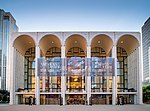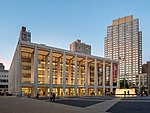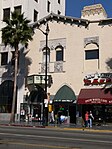Reclining Figure (Lincoln Center)
1965 sculpturesAbstract sculptures in New York CityAbstract sculptures in the United StatesBronze sculptures in ManhattanBronze sculptures in Massachusetts ... and 4 more
Massachusetts Institute of Technology campusOutdoor sculptures in Cambridge, MassachusettsOutdoor sculptures in ManhattanSculptures by Henry Moore

Reclining Figure (Lincoln Center) 1963–5 (LH 519) is a statue by Henry Moore. The original two-part bronze statue of a human figure was commissioned for the Lincoln Center for the Performing Arts in New York City, where it has been displayed outdoors since 1965 in a pool of water to the north of the new Metropolitan Opera House. Other copies in plaster or bronze exist, and are displayed in other cities.
Excerpt from the Wikipedia article Reclining Figure (Lincoln Center) (License: CC BY-SA 3.0, Authors, Images).Reclining Figure (Lincoln Center)
West 64th Street, New York Manhattan
Geographical coordinates (GPS) Address Phone number Nearby Places Show on map
Geographical coordinates (GPS)
| Latitude | Longitude |
|---|---|
| N 40.7732 ° | E -73.98367 ° |
Address
Lincoln Center for the Performing Arts
West 64th Street 10
10023 New York, Manhattan
New York, United States
Open on Google Maps







